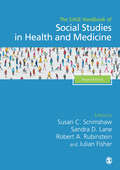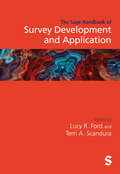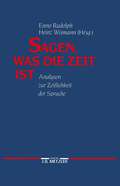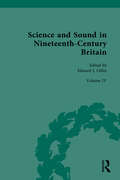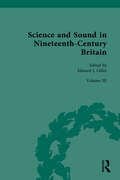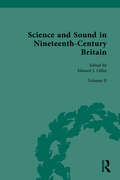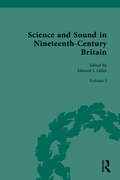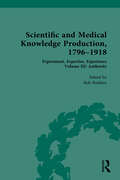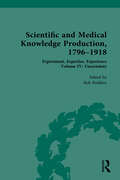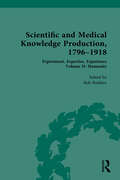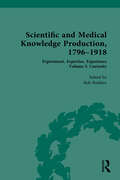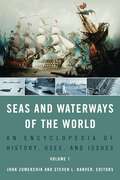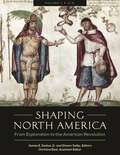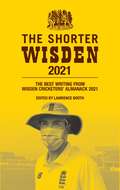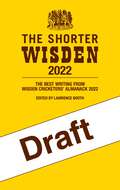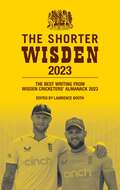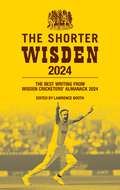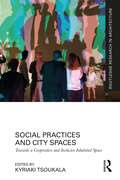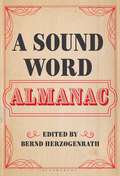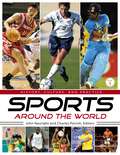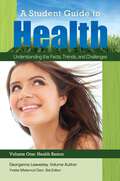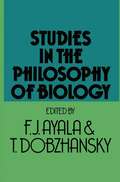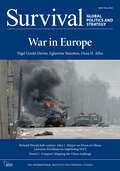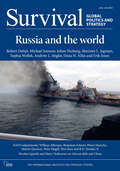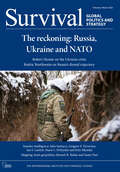- Table View
- List View
The SAGE Handbook of Social Studies in Health and Medicine
With new chapters on key topics such as mental health, the environment, race, ethnicity and health, and pharmaceuticals, this new edition maintains its multidisciplinary framework and bridges the gap between health policy and the sociology of health. It builds upon the success of the first by encompassing a range of issues, studies, and disciplines. The broad coverage of topics in addition to new chapters present an engagement with contemporary issues, resulting in a valuable teaching aid. This second edition brings together a diverse range of leading international scholars with contributors from Australia, Puerto-Rico, USA, Guatemala, Germany, Sri Lanka, Botswana, UK, South Sudan, Mexico, South Korea, Canada and more. The second edition of this Handbook remains a key resource for undergraduates, post-graduates, and researchers across multidisciplinary backgrounds including: medicine, health and social care, sociology, and anthropology. PART ONE: Culture, Society and Health PART TWO: Lived Experiences PART THREE: Health Care Systems, Access and Use PART FOUR: Health in Environmental and Planetary Context
The SAGE Handbook of Survey Development and Application
The SAGE Handbook of Survey Development and Application provides a practical resource that researchers can go to for cutting-edge tools to ensure they are employing the best survey research techniques. This handbook not only covers the classic and innovational skills and approaches involved at every step of the survey research process, but also centres itself around applied, how-to guidance to aid readers in best practice. Chapters engage with a broad range of topics including sampling issues, approaches to establishment of measurement equivalence, and the use of online labour pools in survey development. With contributions from a global community of leading and emerging scholars across a wide variety of disciplines, this Handbook is focused on being applicable and accessible across the social sciences. Containing over 120 tables and figures, checklists and tutorial guides, The SAGE Handbook of Survey Development and Application will serve as a one stop resource for survey research. This handbook serves as a touchstone for a variety of fields such as Organizational Behavior, Industrial & Organizational Psychology, Management, Psychology, Educational Research, Marketing, Public Policy, and others. PART 1: Conceptual Issues and Operational Definition PART 2: Research Design Considerations PART 3: Item Development PART 4: Scale Improvement Methods PART 5: Data Collection PART 6: Data Management and Analysis PART 7: Research Production and Dissemination PART 8: Applications
Science and Sound in Nineteenth-Century Britain: Sound Transformer (Nineteenth-Century Science, Technology and Medicine: Sources and Documents #4)
Sound and Science in Nineteenth-Century Britain is a four-volume set of primary sources which seeks to define our historical understanding of the relationship between British scientific knowledge and sound between 1815 and 1900. In the context of rapid urbanization and industrialization, as well as a growing overseas empire, Britain was home to a rich scientific culture in which the ear was as valuable an organ as the eye for examining nature. Experiments on how sound behaved informed new understandings of how a diverse array of natural phenomena operated, notably those of heat, light, and electro-magnetism. In nineteenth-century Britain, sound was not just a phenomenon to be studied, but central to the practice of science itself and broader understandings over nature and the universe. This collection, accompanied by extensive editorial commentary, will be of great interest to students and scholars of the History of Science.
Science and Sound in Nineteenth-Century Britain: Sound in Context (Nineteenth-Century Science, Technology and Medicine: Sources and Documents #3)
Science and Sound in Nineteenth-Century Britain is a four-volume set of primary sources which seeks to define our historical understanding of the relationship between British scientific knowledge and sound between 1815 and 1900. In the context of rapid urbanization and industrialization, as well as a growing overseas empire, Britain was home to a rich scientific culture in which the ear was as valuable an organ as the eye for examining nature. Experiments on how sound behaved informed new understandings of how a diverse array of natural phenomena operated, notably those of heat, light, and electro-magnetism. In nineteenth-century Britain, sound was not just a phenomenon to be studied, but central to the practice of science itself and broader understandings over nature and the universe. This collection, accompanied by extensive editorial commentary, will be of great interest to students and scholars of the History of Science.
Science and Sound in Nineteenth-Century Britain: Philosophies and Epistemologies of Sound (Nineteenth-Century Science, Technology and Medicine: Sources and Documents #2)
Science and Sound in Nineteenth-Century Britain is a four-volume set of primary sources which seeks to define our historical understanding of the relationship between British scientific knowledge and sound between 1815 and 1900. In the context of rapid urbanization and industrialization, as well as a growing overseas empire, Britain was home to a rich scientific culture in which the ear was as valuable an organ as the eye for examining nature. Experiments on how sound behaved informed new understandings of how a diverse array of natural phenomena operated, notably those of heat, light, and electro-magnetism. In nineteenth-century Britain, sound was not just a phenomenon to be studied, but central to the practice of science itself and broader understandings over nature and the universe. This collection, accompanied by extensive editorial commentary, will be of great interest to students and scholars of the History of Science.
Science and Sound in Nineteenth-Century Britain: Sounds Experimental and Entertaining (Nineteenth-Century Science, Technology and Medicine: Sources and Documents #1)
Sound and Science in Nineteenth-Century Britain is a four-volume set of primary sources which seeks to define our historical understanding of the relationship between British scientific knowledge and sound between 1815 and 1900. In the context of rapid urbanization and industrialization, as well as a growing overseas empire, Britain was home to a rich scientific culture in which the ear was as valuable an organ as the eye for examining nature. Experiments on how sound behaved informed new understandings of how a diverse array of natural phenomena operated, notably those of heat, light, and electro-magnetism. In nineteenth-century Britain, sound was not just a phenomenon to be studied, but central to the practice of science itself and broader understandings over nature and the universe. This collection, accompanied by extensive editorial commentary, will be of great interest to students and scholars of the History of Science.
Scientific and Medical Knowledge Production, 1796-1918: Volume III: Authority
Increasingly, critics accused practitioners of hiding hubris behind their purported humanity and questioned whether an increasingly professional scientific community could retain its grip on the meaning of compassion. This volume presents a set of responses to this criticism and others, showing the extent to which the lived-experience of scientific practice became a justification in and of itself for the expression of social, political and cultural authority. Bare knowledge, as it was presented, came with an enormous social valuation. These sources show how that authority changed and grew over time.
Scientific and Medical Knowledge Production, 1796-1918: Volume IV: Uncertainty
This volume showcases doubt from within the scientific community itself. These sources dwell upon the moments at which ideas became challenged, when facts were revealed to be fiction, and when knowns reverted to unknowns. But the focus is not the ideas and facts themselves, but on the ways in which scientists adjusted themselves to new landscapes of uncertainty in their particular cultural and professional practices.
Scientific and Medical Knowledge Production, 1796-1918: Volume II: Humanity
This volume foregrounds humanity (in the sense of compassion or sympathy), which often supplied the motivation for medical experiment and scientific innovation. Though the results of experiments could not be known in advance, often the stated goal was the reduction of suffering, the cure of disease, or the easement of life. Increasingly, critics accused practitioners of hiding hubris behind their purported humanity and questioned whether an increasingly professional scientific community could retain its grip on the meaning of compassion.
Scientific and Medical Knowledge Production, 1796-1918: Volume I: Curiosity
This volume is divided according to moral themes within medicine and science. The sources represent dominant notes within the culture of knowledge production that capture the moral/emotional/social justification for the making of expertise through experiment. This volume focuses on curiosity, given as the scientist’s chief motivating factor for the finding of new facts, and as an essential character trait for anyone entering the scientific life. It is also the source of controversy and criticism, since curiosity alone increasingly looked amoral at best and immoral at worst, as the nineteenth century wore on.
Seas and Waterways of the World [2 volumes]: An Encyclopedia of History, Uses, and Issues [2 volumes]
This is the first comprehensive encyclopedia on the history of the vast and varied ways human beings have used the world's waterways for business, protection, and recreation.Seas and Waterways of the World: An Encyclopedia of History, Uses, and Issues offers a comprehensive introduction to humanity's historical reliance on the world's seas and waterways and how that reliance continues to evolve.Over the course of two volumes, this extraordinary resource describes the world's major nautical features, the wide variety of uses for those waterways, and a number of essential issues arising from water-borne commerce. The encyclopedia marks the emergence of the aquarium, cruise, energy, fishing, insurance, mining, trade, transportation, recreation, and sport industries, and includes entries on harbors, ports, and coastal development that play a part in the economics of commercial water use. Also included is coverage of a number of significant themes such as the rise and fall of the Erie Canal as the gateway to the Midwest, and the declining popularity of the Panama Canal.
Shaping North America [3 volumes]: From Exploration to the American Revolution [3 volumes]
This fascinating multivolume set provides a unique resource for learning about early American history, including thematic essays, topical entries, and an invaluable collection of primary source documents.In 1783, just months after the United States achieved independence from Great Britain, General George Washington was compelled to convince his officers not to undertake a military coup of the Congress of Confederation. Had the planned mutinous coup of the Newburgh Conspiracy gone forward, the American experiment may have ended before it even began. The pre-colonial and colonial periods of early American history are filled with accounts of key events that established the course of our nation's development. This expansive three-volume set provides entries on a wide variety of topics and themes in early American history to elucidate how the United States came to be. Written in straightforward language, the encyclopedic entries on social, political, cultural, and military subjects from the pre-Columbian period through the creation of the Constitution (roughly 1400–1790) will be useful for anyone wishing to deeply investigate the who, what, where, when, and why of early America. Additionally, the breadth of primary documents—including personal diaries, letters, poems, images, treaties, and other legal documents—provides readers with firsthand sources written by the men and women who shaped American history, both the famous and the less well known. Each of the three volumes also presents thematic essays on highlighted topics to fully place the individual entries within their proper historical context and heighten readers' comprehension.
The Shorter Wisden 2021: The Best Writing from Wisden Cricketers' Almanack 2021
The Shorter Wisden is a compelling distillation of what's best in its bigger brother – and the 2021 edition of Wisden is crammed, as ever, with the best writing in the game. Wisden's digital version includes the influential Notes by the Editor, and all the front-of-book articles.In an age of snap judgments, Wisden's authority and integrity are more important than ever. Yet again this year's edition is truly a “must-have” for every cricket fan. In essence, The Shorter Wisden is a glass of the finest champagne rather than the whole bottle.@WisdenAlmanack
The Shorter Wisden 2022: The Best Writing from Wisden Cricketers' Almanack 2022
The Shorter Wisden is a compelling distillation of what's best in its bigger brother – and the 2022 edition of Wisden is crammed, as ever, with the best writing in the game. Wisden's digital version includes the influential Notes by the Editor, and all the front-of-book articles.In an age of snap judgments, Wisden's authority and integrity are more important than ever. Yet again this year's edition is truly a “must-have” for every cricket fan. In essence, The Shorter Wisden is a glass of the finest champagne rather than the whole bottle.@WisdenAlmanack
The Shorter Wisden 2023: The Best Writing from Wisden Cricketers' Almanack 2023
The most famous sports book in the world, Wisden Cricketers' Almanack has been published every year since 1864. The selected writings from the 160th edition contained in this eBook offer trenchant opinion, compelling features and an authoritative voice on the worldwide game.The Shorter Wisden is a compelling distillation of what's best in its bigger brother – and the 2023 edition of Wisden is crammed, as ever, with the best writing in the game. Wisden's digital version includes the influential Notes by the Editor, and all the front-of-book articles.In an age of snap judgments, Wisden's authority and integrity are more important than ever. Yet again this year's edition is truly a “must-have” for every cricket fan. In essence, The Shorter Wisden is a glass of the finest champagne rather than the whole bottle.@WisdenAlmanack
The Shorter Wisden 2024: The Best Writing from Wisden Cricketers' Almanack 2024
The most famous sports book in the world, Wisden Cricketers' Almanack has been published every year since 1864. The selected writings from the 161st edition contained in this eBook offer trenchant opinion, compelling features and an authoritative voice on the worldwide game.The Shorter Wisden is a distillation of what's best in its bigger brother – and the 2024 edition of Wisden is crammed, as ever, with the best writing in the game. Wisden's digital version includes the influential Notes by the Editor, and all the front-of-book articles. In essence, The Shorter Wisden is a glass of the finest champagne rather than the whole bottle. In an age of snap judgments, Wisden's authority and integrity are more important than ever. Yet again this year's edition is truly a “must-have” for every cricket fan.@WisdenAlmanack
Social Practices and City Spaces: Towards a Cooperative and Inclusive Inhabited Space (Routledge Research in Architecture)
This book examines the relationship between social practices and built space, focusing on current cooperative/participative and posthuman approaches to its production and management. From a social-cultural-and-ecological perspective, it explores the modes of engagement of all factors in the constitutional processes of inhabited space. Throughout this interdisciplinary collection, built space is reconsidered in the light of other schools of thought such as philosophy, anthropology, social sciences and political theories and practices. It covers new ground at conceptual, epistemic and methodological levels, focusing on inhabited space from within the framework of globalisation, biopolitics, cultural changes, environmental crisis and new technologies. Organised into three parts, Parts 1 and 2 focus on the role of architects in the emergence of a new ethos for habitation, as well as the modalities of the inclusion of differences in design, discussing the importance of participation and narrative at a theoretical and practical level in architecture. In the third part, the chapters delve into questions regarding the intersection of design, ecology and technoscience in a posthuman approach, which might support the inclusion of differences in design and the emergence of a new environmental ethos. Providing a stimulating landscape of arguments and challenges to new readings of architecture, society and the environment, this book will be of interest to researchers, students and professionals of architecture, urban planning, anthropology and philosophy.
A Sound Word Almanac
This almanac of sound words important to artists and scholars highlights words that expand the way we speak (and write) about sonic experiences.Why write about sound, and how? If sonic philosophy is the attempt "to think about sound by philosophical means," then a metaphilosophical debate appears almost immediately on the horizon: What is called for is an understanding about sound and language, but also about the preconditions of musical understanding. What is at stake is the question of language and sound, as well as expanding how we speak about sonic experience.This almanac tackles these questions from artistic, experimental and personal perspectives. An assemblage of nearly 70 practitioners and theoreticians, artists and scholars offer their favorite 'sound word.' These sound words are onomatopoetical, mythological, practical; words of personal importance to the artists and their craft; words from their memory, related to sound. Many entries are not in English – some are untranslatable – and all are accompanied by a personal, explanatory, poetic entry. These are words that have the potential to change our perspective on listening-musicking-thinking.
Sports around the World [4 volumes]: History, Culture, and Practice [4 volumes]
This multivolume set is much more than a collection of essays on sports and sporting cultures from around the world: it also details how and why sports are played wherever they exist, and examines key charismatic athletes from around the world who have transcended their sports.Sports Around the World: History, Culture, and Practice provides a unique, global overview of sports and sports cultures. Unlike most works of this type, this book provides both essays that examine general topics, such as globalization and sport, international relations and sport, and tourism and sport, as well as essays on sports history, culture, and practice in world regions—for example, Latin America and the Caribbean, the Middle East and North Africa, Europe, and Oceania—in order to provide a more global perspective. These essays are followed by entries on specific sports, world athletes, stadiums and arenas, famous games and matches, and major controversies. Spanning topics as varied as modern professional cycling to the fictional movie Rocky to the deadly ball game of the ancient Mayans, the first three volumes contain overview essays and entries for specific sports that have been and are currently practiced around the world. The fourth volume provides a compendium of information on the winners of major sporting competitions from around the world.Readers will gain invaluable insights into how sports have been enjoyed throughout all of human culture, and more fully comprehend their cultural contexts. The entries provide suggestions for further reading on each topic—helpful to general readers, students with school projects, university students and academics alike. Additionally, the four-volume Sports Around the World spotlights key charismatic athletes who have changed a sport or become more than just an outstanding player.
A Student Guide to Health [5 volumes]: Understanding the Facts, Trends, and Challenges [5 volumes]
This comprehensive, five-volume reference set is aligned with the National Health Education Standards, containing up-to-date, scientifically based information on a variety of health and wellness topics relevant to high school students.A Student Guide to Health: Understanding the Facts, Trends, and Challenges provides straightforward, factual, and accessible information about a multitude of health issues. It is an essential reference set that provides high school students, teachers, and administrators with a comprehensive health and wellness education resource that aligns with National Health Education Standards and common health curriculum. This expansive five-volume set is ideal for students' research projects; highly useful as a resource for community college and public library patrons, librarians, teens, and parents; and is a suitable supplement to any health education curriculum.Each chapter includes up-to-date, evidence-based information that provokes further examination and encourages critical thinking to evaluate the validity of information encountered about health and wellness topics. Each chapter provides an abundance of references and lists of resources for further information, including books, articles, websites, organizations, and hotlines. Special attention is paid to social trends that affect youth health and wellness, such as bullying, eating disorders, steroid abuse, sexting, and the peer pressure associated with drug use and abuse.
Survival: War in Europe
Survival, the IISS’s bimonthly journal, challenges conventional wisdom and brings fresh, often controversial, perspectives on strategic issues of the moment.In this issue:Nigel Gould-Davies assesses that Russia’s war has not only unleashed countervailing strength among Ukrainians and Ukraine’s supporters, but also shattered myths about Russia’s own strengthPaul Meyer considers how an arms race in outer space, where orbital debris is already a cause of concern, might be restrainedKelsey Davenport contends that the US should embed denuclearisation within a broad set of transformational goals in future negotiations with North KoreaJonathan (Yoni) Shimshoni examines the North’s flawed application of a society-centric strategy towards the South during the American Civil WarAnd nine more thought-provoking pieces, as well as our regular Book Reviews and Noteworthy column.Editor: Dr Dana AllinManaging Editor: Jonathan StevensonAssociate Editor: Carolyn WestAssistant Editor: Jessica WatsonEditorial Assistant: Charlie Zawadzki
Survival: Russia and the World
Survival, the IISS’s bimonthly journal, challenges conventional wisdom and brings fresh, often controversial, perspectives on strategic issues of the moment.In this issue: Robert Dalsjö, Michael Jonsson and Johan Norberg reconsider Russia’s military capability given its recent battlefield performance in Ukraine William Alberque and Benjamin Schreer argue that Finland and Sweden’s NATO membership would, if managed judiciously, bolster deterrence and European security Chuck Freilich contends that encouraging diplomacy is the best of Israel’s limited options for postponing Iran’s nuclear-weapons programme Nicolas Lippolis and Harry Verhoeven assess that if a wave of African defaults materialises in the near future, it will be catalysed more by private-sector manoeuvring and intransigence than by Chinese scheming Dana H. Allin and Erik Jones argue that Russia’s isolation is not a viable endgame for the West, but it may be unavoidable for a generation And seven more thought-provoking pieces, as well as our regular Book Reviews and Noteworthy column.Editor: Dr Dana AllinManaging Editor: Jonathan StevensonAssociate Editor: Carolyn WestAssistant Editor: Jessica WatsonEditorial Assistant: Charlie Zawadzki
Survival February - March 2022: The Reckoning: Russia, Ukraine and NATO
Survival, the IISS’s bimonthly journal, challenges conventional wisdom and brings fresh, often controversial, perspectives on strategic issues of the moment.In this issue:· The Ukraine crisis: Robert Hunter argues that the most important requirement of successful US-led negotiations with Russia is that Moscow demonstrate that it is prepared to be a responsible international actor· Erin Sikorsky contends that climate change should have a larger role in the day-to-day national-security agendas of the United States and other countries· Stephan Frühling and Andrew O’Neil warn that current US debates about no first use tend to underplay the broader alliance implications of any shift in US nuclear policy· Rahul Roy-Chaudhury and Kate Sullivan de Estrada assess that, given the 2021 US FONOP targeting India, Washington and New Delhi need to better manage their diverse positions on global governance, especially in the maritime domain· Nien-chung Chang-Liao warns that pragmatism in Chinese foreign policy is waning and considers why Chinese diplomats have become so aggressiveAnd nine more thought-provoking pieces, as well as our regular Book Reviews and Noteworthy column.Editor: Dr Dana AllinManaging Editor: Jonathan StevensonAssociate Editor: Carolyn WestAssistant Editor: Jessica Watson
